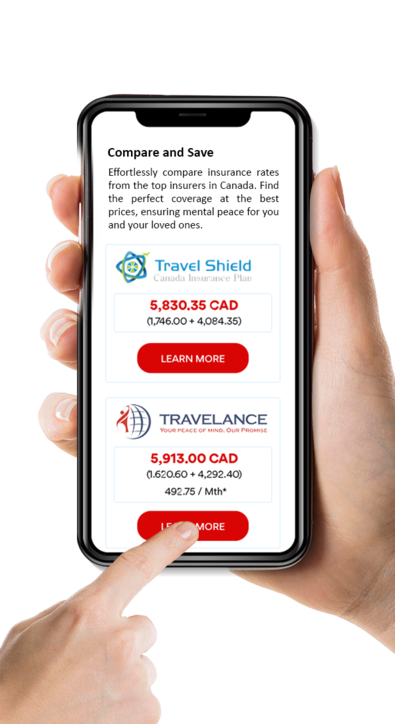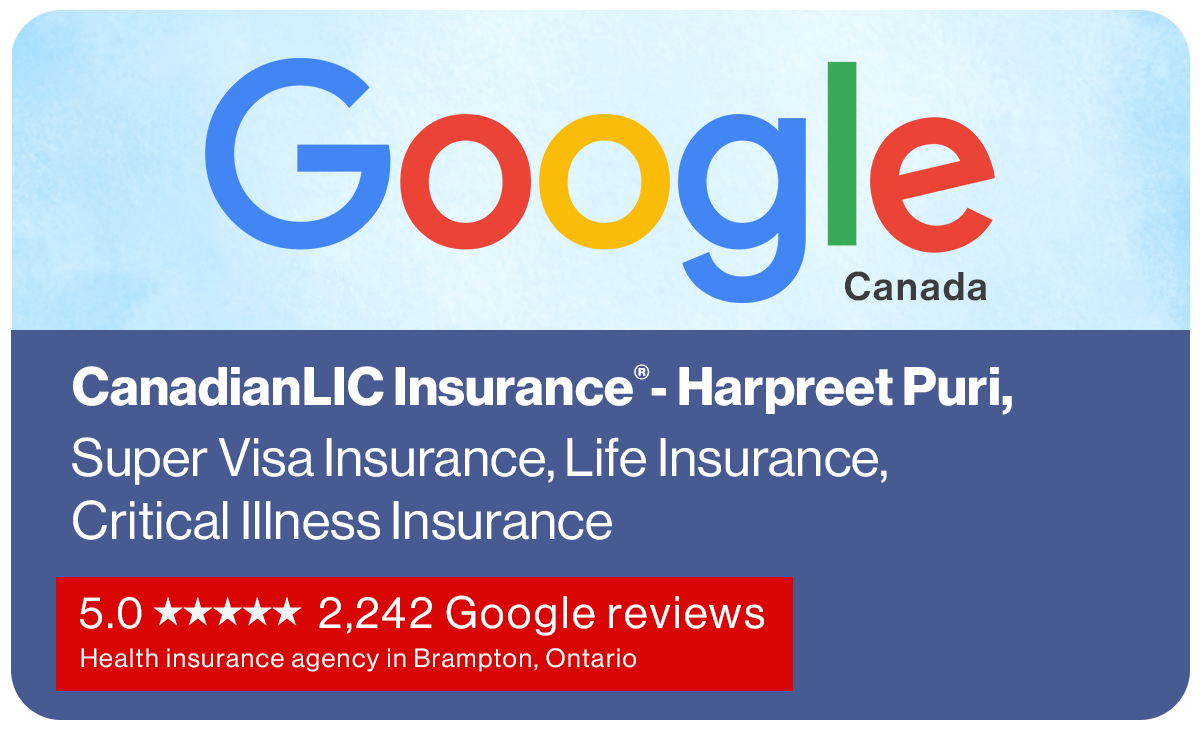Total Coverage Quotes*
CAD $4,257,165,000


Compare & get lowest quotes
From Canada's top insurers



WELCOME TO Canadian L.I.C. INC
What is Term Life Insurance?
Term Life Insurance is a type of life insurance coverage provided for a fixed period, typically between 10 and 30 years. These policies are designed to offer financial protection to your family by replacing lost income in the event of the policyholder’s death during the term, in case the policy expires, coverage ends unless renewed or converted into a Permanent Life Insurance Policy.
There are also certain Term Policies for special uses: An annual renewable term is a one-year Life Insurance Policy where your premiums are locked in for a year, and you have the option to renew every year after that. It is sometimes referred to as a yearly renewable term. Decreasing Term Policies are a type of Term Life Insurance Policy where the death benefit decreases over the life of the policy.

Compare The Various Canadian Term Life Insurance Plans
Comparing different Term Life Insurance Policies in Canada is now easier than ever. Simply complete our quick form to instantly view and compare Term Life Insurance Rates by age from leading insurers. Whether you’re looking for a 10, 20, or 30-year plan, we help you find coverage that fits your life and budget. In just minutes, you’ll know your eligibility and cost, making it simple to choose the most Flexible Term Life Insurance Plans tailored to your evolving needs and those of your family.
How Does Term Life Insurance Work?
Under Term Life Insurance Canada, the policyholder makes periodic payments to maintain his or her coverage. If the policyholder dies within the period of coverage, the insurance company pays a death benefit to the beneficiaries named within the policy. No cash value is built up under the policy, which typically has the objective of providing financial security for dependents.
How Much Does Term Life Insurance Cost in Canada?
Term Life Insurance Policies in Canada vary in cost depending on your age, health, and the coverage amount you choose. Canadian providers offer some of the most competitive rates available, which makes comparing Term Life Insurance Plans essential. Since prices can differ significantly, it’s important to review Term Life Insurance rates by age and coverage type. Speaking with an expert can help you find a plan tailored to your needs and budget.
Learn more about the Term Life Insurance Plan For All Age Groups
Need a Quick Term Life Insurance Quote?
Our licensed insurance experts are available to help with all your insurance needs.
Table of contents

Male
Term Life Insurance Monthly Premiums by Age and Coverage Amount
| Age | $250,000 Coverage | $500,000 Coverage | $1,000,000 Coverage |
|---|---|---|---|
| 30 | $18/month | $30/mont | $52/month |
| 35 | $19/month | $31/month | $54/month |
| 40 | $27/month | $45/month | $84/month |
| 45 | $43/month | $72/month | $136/month |
| 50 | $70/month | $124/month | $236/month |
| 55 | $125/month | $214/month | $407/month |
| 60 | $217/month | $403/month | $787/month |
| 65 | $374/month | $675/month | $1,283/month |
Female
| Age | $250,000 Coverage | $500,000 Coverage | $1,000,000 Coverage |
|---|---|---|---|
| 30 | $14/month | $22/month | $35/month |
| 35 | $15/month | $23/month | $40/month |
| 40 | $20/month | $34/month | $60/month |
| 45 | $30/month | $52/month | $95/month |
| 50 | $48/month | $83/month | $154/month |
| 55 | $84/month | $153/month | $295/month |
| 60 | $151/month | $281/month | $514/month |
| 65 | $246/month | $456/month | $873/month |
Note- This quote is for a 20-year Term Life Insurance Policy for a healthy, non-smoking individual, categorized by gender. Please note that 20-year term coverage is available only up to age 65.
Average Term Life Insurance Premium Costs by Coverage Amount
MALE – NON-SMOKER
| Age | $50K Premium | $500K Premium | $1M Premium |
|---|---|---|---|
| 30 | $10/month | $30/month | $52/month |
| 35 | $11/month | $31/month | $54/month |
| 40 | $12/month | $45/month | $84/month |
| 45 | $14/month | $72/month | $134/month |
| 50 | $21/month | $124/month | $236/month |
| 55 | $35/month | $214/month | $407/month |
| 60 | $58/month | $403/month | $787/month |
| 65 | $100/month | $675/month | $1,283/month |
MALE – SMOKER
| Age | $50K Premium | $500K Premium | $1M Premium |
|---|---|---|---|
| 30 | $10/month | $30/month | $52/month |
| 35 | $11/month | $31/month | $54/month |
| 40 | $12/month | $45/month | $84/month |
| 45 | $14/month | $72/month | $134/month |
| 50 | $21/month | $124/month | $236/month |
| 55 | $35/month | $214/month | $407/month |
| 60 | $58/month | $403/month | $787/month |
| 65 | $100/month | $675/month | $1,283/month |
FEMALE – NON-SMOKER
| Age | $50K Premium | $500K Premium | $1M Premium |
|---|---|---|---|
| 30 | $10/month | $30/month | $52/month |
| 35 | $11/month | $31/month | $54/month |
| 40 | $12/month | $45/month | $84/month |
| 45 | $14/month | $72/month | $134/month |
| 50 | $21/month | $124/month | $236/month |
| 55 | $35/month | $214/month | $407/month |
| 60 | $58/month | $403/month | $787/month |
| 65 | $100/month | $675/month | $1,283/month |
FEMALE – SMOKER
| Age | $50K Premium | $500K Premium | $1M Premium |
|---|---|---|---|
| 30 | $10/month | $30/month | $52/month |
| 35 | $11/month | $31/month | $54/month |
| 40 | $12/month | $45/month | $84/month |
| 45 | $14/month | $72/month | $134/month |
| 50 | $21/month | $124/month | $236/month |
| 55 | $35/month | $214/month | $407/month |
| 60 | $58/month | $403/month | $787/month |
| 65 | $100/month | $675/month | $1,283/month |
Note- This quote is for a 20-year term for an individual in good health, categorized by gender and smoking status. Please note that 20-year term coverage is available only up to age 65.
Term Life Insurance Quotes in Canada for Males
| Age | 10-Year Term | 20-Year Term | 30-Year Term |
|---|---|---|---|
| 20 | $22/month | $29/month | $34/month |
| 30 | $22/month | $30/month | $45/month |
| 40 | $28/month | $45/month | $88/month |
| 50 | $62/month | $117/month | $239/month |
| 60 | $180/month | $380/month | Not available |
Term Life Insurance Quotes in Canada for Females
| Age | 10-Year Term | 20-Year Term | 30-Year Term |
|---|---|---|---|
| 20 | $14/month | $20/month | $24/month |
| 30 | $15/month | $22/month | $33/month |
| 40 | $20/month | $34/month | $64/month |
| 50 | $45/month | $83/month | $166/month |
| 60 | $127/month | $267/month | Not available |
Note- Quotes are based on $100,000 in coverage for a non-smoker in regular health. Participating policies include cash value and dividends, while non-participating policies only have cash value.

How Much Term Life Insurance Coverage Do I Need
Before you apply for Term Life Insurance, you should think about your financial obligations and who depends on you. The first thing you should do is get quotes for Term Life Insurance from well-known agents. Term Life Insurance is often one of the most affordable types of insurance. It will protect you for most of your life. So, listen to what the Canadian LIC team has to say. Look at the different plans that are available and choose the best one that will protect your family’s financial future.
What Does Term Life Insurance Cover?
Term Life Insurance covers primarily the risk of death. The Death Benefit could help beneficiaries manage financial obligations such as mortgage payments, educational expenses, and living costs. It can also cover funeral expenses and debts. Additional riders may be included in some policies.
Does Term Life Insurance Cover Accidental Death?
When people apply for Term Life Insurance in Canada online, it means that their loved ones will be financially safer in the future. If the insured dies because of an accident during the policy term, then the death benefit will be paid to the beneficiaries. When you are getting Term Life Insurance quotes online, make sure that you check with Term Life Insurance Brokers that your plans cover accidental death. All Term Life Insurance Policies are different and include their own terms and exclusions, so make sure to read all the fine print so that you have the coverage you want.
Does Term Life Insurance Cover Disability?
Term Life Insurance in Canada (as a standard) can not cover disability. Term Life Insurance Policy: provides a death benefit to your loved ones if you die during the term of the policy. Despite this, a number of Canadian Term Life Insurance Companies offer riders that can easily be added to your Term Life Insurance, such as disability riders that pay benefits if you become disabled due to an injury or illness. Contact Canadian LIC’s Term Life Insurance Brokers to know these options further or request Term Life Insurance quotes to see what other coverage options are available.
Learn more about What does Term Life Insurance cover and not cover?
If in Doubt About Coverage
Our Advisors Can Assist with Any Queries You May Have!
Give Us a Call at 1-416-543-9000
How Do Insurance Companies Calculate the Cost of Your Life Insurance Premiums?
Right, so insurance companies have got so many different things that go into what the premium cost for a Life Insurance Policy will be. Below is an in-depth breakdown of the major components involved:
1. Mortality Tables
Mortality or life tables are tools used by insurance companies to estimate the expectation of life and probability of death at a given age as applied to a group of people. They are usually compiled using statistical records on death rates and are vital in ascertaining a level of risk exposure in insuring an individual. In such a situation, the other things remaining constant, such as the premium on insurance, will be lower when the probability of death is low, according to the table.
2. Life Expectancy
Life expectancy is directly derived from mortality tables and expressed in relation to the age of a person, showing on average how many years remain in his or her life. This information is then used by the insurers to determine how long they likely will be paying out on a policy, adjusting its premiums accordingly. Young people, for example, generally have a greater life expectancy, which normally translates to lower premiums based on the likelihood that the insurer will collect over a longer period before a potential payout.
3. Company’s Personal Financial Strategies.
Premium rates can also be influenced by the financial health and strategies of an insurance company. Companies may price their products based on the return that they would want to make on the premiums paid. Hence, if the investment performance is good, then a firm might be in a position to charge lower premiums because of high returns on the invested premiums.
4. Collection of Premiums
How premiums are collected—monthly, quarterly, or annually—can make a difference in their overall cost. Where premiums are paid in an annual schedule, that is likely to have a lesser cost compared to other frequencies, as this reduces administrative costs and minimizes the payment default risk on the part of the policyholder.
5. Individual Risk Factors
Age: This is the most important factor in premium rates for life insurance. The older you are, the higher the premium charged normally since the risk of death is higher at an older age.
Health: Many insurance companies require a medical examination or access to your medical history report to review your state of health. Poor health or pre-existing conditions may attract higher premiums.
Smoking Status: Since smokers are more predisposed to a number of health complications than nonsmokers, they have to pay higher premiums. This can sometimes result in a very high premium for a smoker, relative to a non-smoker, in life insurance due to the enhanced risk of contracting diseases associated with tobacco intake.
Each of these factors helps insurance companies mitigate their risk and ensure profitability while providing necessary coverage to their clients. To obtain this information and ensure its accuracy, insurance companies rely on actuarial science, which involves statistics and probability to predict risk and life expectancy.
What Affects Life Insurance Prices?
Term Life Insurance Policies in Canada are priced based on several key factors. Age and health play a significant role in determining your premiums, as older applicants or those with health issues generally pay more. Smokers are usually charged higher premiums than non-smokers due to increased health risks. Term length and coverage amount also impact the cost. Since Term Life Insurance Rates by age and other variables differ between providers, it’s crucial to compare quotes before choosing a plan.
What to Do When Your Term Life Insurance Expires?
Term Life Insurance Policies in Canada typically provide a payout only if the policyholder passes away during the coverage term. If your policy ends before that, it’s important to assess your current financial needs and decide whether to renew, convert, or explore a new plan. Reviewing online Term Life Insurance quotes can help you compare new rates against your current coverage. Many providers allow you to convert your Term Plan into Permanent Coverage without a medical exam. Consulting with licensed Term Life Insurance Agents can help you understand your best options moving forward. Regardless of your course of action, whether to renew, convert, or buy a new Term Life Insurance Plan, it is important to evaluate both your financial goals and your coverage to ensure that you remain protected.
Learn more about Understanding the Uses of a Term Insurance Calculator
What’s the Difference Between Term Life Insurance and Whole Life Insurance?
Term Life Insurance vs. Whole Life Insurance in Canada meets differing financial planning needs. In Canada, with a Term Life Insurance Policy, the protection has been for just a fixed time, for example, 10 or 20 up to 50 years or till age 85. Famous for being inexpensive, a lot of people shop for Short-Term Life Insurance policies for their needs, such as a mortgage. Whole life provides lifelong coverage and has an investment component, so it is, as a result, more expensive than term life. The many companies offering Term Life Insurance in Canada may each provide several plans, and Life Insurance Brokers can help you compare term policies or choose between Term Life Insurance in Canada and more permanent varieties.
How To Get An Affordable Term Life Insurance Policy
If you’re looking to acquire Term Life Insurance in Canada, start by requesting Term Life Insurance quotes online from multiple Term Life Insurance companies. Canadian LIC Term Life Insurance Brokers can help you compare various Term Life Insurance Policies to find the Term Life Insurance Plan that best fits your financial goals. When selecting a Term Life Policy, it’s important to consider key factors such as the coverage amount, term length, and monthly premium. A knowledgeable Term Life Insurance broker will guide you through the application process. We recommend comparing multiple quotes to secure the most suitable Term Life Insurance coverage for your needs.
Learn more about What’s the longest Term Life Insurance you can get?
Get the best Insurance Quote from Canadian L.I.C
Call 1 844-542-4678 to speak to
our advisors.









